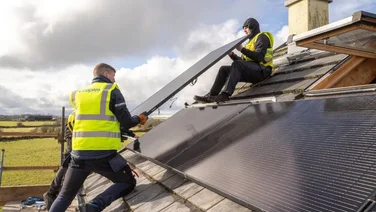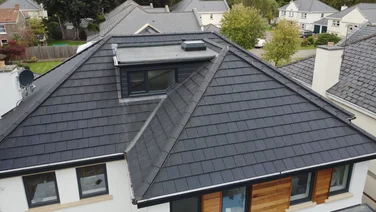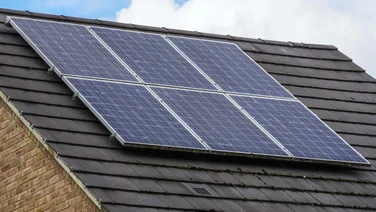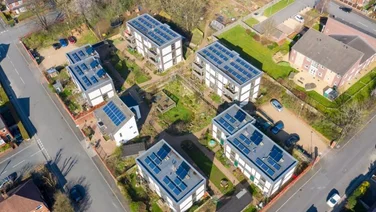Climate change deniers often point to China’s high carbon emissions as a reason for inaction on renewables here in the UK, but China’s dominance of the solar industry means the world is currently dependent on it in the fight against climate change and governments in North America and Europe are scrambling to keep up.
While it’s true that China is responsible for around 30% of the world’s annual emissions, the highest share of any country, compared to the UK’s 1%, China’s huge investment in renewable energy, especially solar, shows how the country sees itself in the fight to cut global emissions, and the economic opportunity that presents.
For example, 2023 was a record year for renewable growth, largely driven by China’s solar PV market. China also manufactures most of the world’s renewable tech, especially solar PV equipment, electric vehicles (EVs), and batteries, exporting these products to the rest of the world.
Given this, it is likely that most of the world will be reliant on China for solar, wind turbines, EVs and battery technology in the coming years, if they are not already.
In this article, we’ll look at how China dominates the solar industry, including why it manufactures most of the world’s solar panels, its solar capacity, and the role China has to play in helping the world achieve net zero emissions.

Why are most solar panels made in China?
China’s strength in solar panel manufacturing is largely down to favourable government policies that have encouraged investment in the solar PV sector.
According to the International Energy Agency (IEA), China has invested US$50 billion in new solar PV supply capacity over the past 10 years, which is ten times more than European countries combined.
According to an analysis by Carbon Brief, growth in renewables in China is largely thanks to a massive increase in private investment in clean tech manufacturing, enabled by government policies such as subsidies and tax incentives.
The government’s 2020 announcement that China would be ‘carbon neutral’ by 2060, and its 2022 new Five-Year Plan to develop a sustainable economic model, have also served as a signal to investors that green tech is the future of the country’s economy, according to Carbon Brief’s analysis.
Policies focused on growing domestic demand for solar PV have also allowed China to manufacture solar PV equipment on a large scale, driving down costs by more than 80% over the last decade, and giving Chinese-made solar PV equipment a competitive advantage in the global market.
China’s solar panel market share
China now accounts for over 80% of global solar panel market share, at all stages of production according to the IEA. This is expected to rise to 95% in the coming years.
By contrast, Europe only accounts for just 3%, while North America (the USA and Canada), account for a little over 2%.
China’s dominance of the solar PV supply chain is best illustrated by the fact that it supplies over 95% of solar panels used in the EU. This is unlikely to change anytime soon.
In February 2024, Europe’s solar power industry warned that it could face bankruptcy without EU financial support, because it could not compete with the cheap, heavily government subsidised supply coming from China.
However, help doesn’t seem forthcoming.
Mairead McGuinness, the European Commissioner for financial services, said in an address in February 2024 that “any potential measures must be weighed against the goals
[the EU has]
set for the energy transition.” This seemed to indicate that the EU would prioritise reaching its net zero targets over boosting the regional solar PV industry.
The US has made a point of avoiding China-based companies when it comes to solar, getting most of its solar panels from Vietnam, Malaysia, Thailand, and Cambodia, despite the fact that manufacturers in these countries often source their materials from China.
Who are the largest solar panel manufacturers in China?
The largest solar panel manufacturers in China include Tongwei Solar, JA Solar, Aiko Solar, and LONGi Solar, all of which are also the top global solar PV manufacturers.
In general, Chinese companies dominate the top 10 list for solar panel manufacturers, with most of the top companies exporting their products overseas to regions such as Europe and North America.
All have significant achievements under their belt, with Aiko Solar solar’s panels regularly ranked among the most efficient worldwide.
JA Solar also recently announced the construction of its first solar module production factory in the US, in Phoenix, Arizona. The investment is worth US$60 million, showing the Chinese company’s ambition to establish itself as a top supplier to the American solar market.
What is China’s solar power capacity?
As of the end of 2023, China’s solar power capacity tops 600 gigawatts (GW), accounting for 58% of the world’s total solar capacity, and placing it in first place worldwide.
China outstrips other countries by a long shot, with the US only having 161 GW of installed solar capacity as of the end of 2023, and the UK having a little over 15 GW.
This is hardly surprising when you consider that China is home to some of the largest solar farms in the world, including the largest, Golmud Solar Park, which has a capacity of 2.8 GW.
China’s solar capacity is expected to double in the next three years, topping 1 TW in 2026.
China’s solar capacity growth
China’s solar capacity has increased dramatically over the past decade, going from just 4.2 GW in 2012, to 125 GW in 2017, to over 600 GW in 2023.
In that same time period, the UK’s solar capacity has only increased by a little under tenfold, going from 1.7 GW in 2012, to 15 GW as of 2023.
China added 216 GW’s worth of solar capacity in 2023 alone, a record increase of 55.2% compared to the previous year. It commissioned as much solar PV in 2023 as the entire world did in 2022, according to the IEA, a staggering feat.
Can the world reduce emissions without China’s help?
As things stand, the world is heavily reliant on China when it comes to reducing emissions, for two reasons.
Firstly, as the world’s biggest emitters, but also as the country installing the most renewables, any reduction to China’s domestic emissions would have a big impact on global emissions.
The IEA expects China to account for 60% of new renewable energy capacity installed by 2028, driven largely by solar and onshore wind.
By 2030, the IEA has forecast that half of China’s electricity generation will come from renewables, which would mean a massive cut to both China’s domestic emissions, and global emissions.
Secondly, China is a powerhouse for green tech manufacturing, which means other countries are reliant on its products to decrease their own emissions.
As we’ve stated, 80% of solar PV equipment is currently manufactured by China. This has raised fears among leaders in Europe and the US that overreliance on China for reaching net zero emissions is risky both politically and economically.
The US, for example, in December 2023 imposed tariffs on solar cells and panels imported from China, in what Forbes referred to as an intensification of “the Sino-American trade war in the renewable energy sector”.
In response to the west’s growing concerns over Chinese imports, Dennis She, the vice president of LONGi Solar, a company that holds 20% of the market share for solar panels, put out a statement warning western leaders that restricting Chinese companies’ would slow down decarbonisation.
He cautioned that without Chinese solar panels, solar panel costs in the US would double, and Europe would fail to meet its 2030 targets for renewable energy generation.
Summary
China currently dominates the solar panel industry, with an 80% share of the market, and this is likely to increase in the coming years.
With their high manufacturing capacity, Chinese solar PV companies have not only helped increase solar generation worldwide, they’ve also contributed to a reduction in the cost of solar PV equipment, with solar now being the cheapest form of renewable energy.
However, there are doubts as to whether China will be able to keep up with the ever-growing demand for solar PV, as governments around the world work to decarbonise their energy supplies and reduce emissions.
In a 2022 report, the IEA found that global production capacity of solar PV would need to more than double by 2030 for net zero emissions to be reached by 2050. The report argued that the only way to do this was for other countries, besides China, to ramp up their manufacturing.
If countries in Europe and North America rise to this challenge, China’s grip on the solar industry could loosen in the coming decades, but not without significant government investment, or at least more incentivisation of private investment in the sector.





